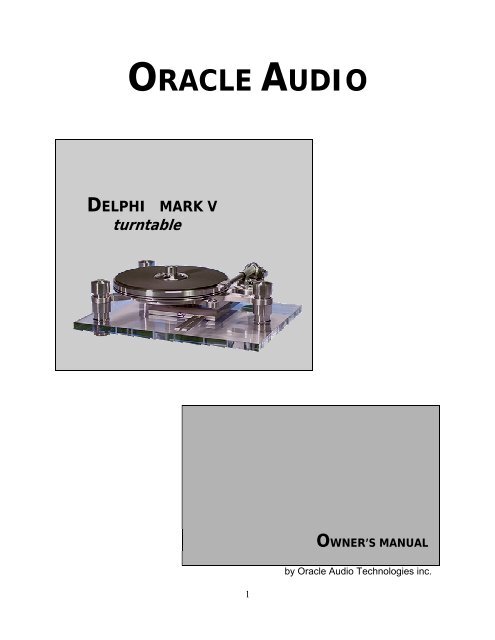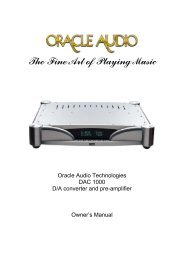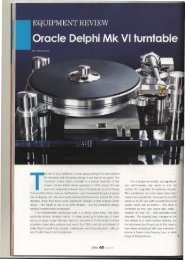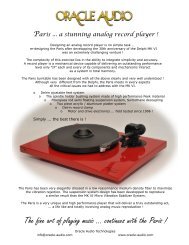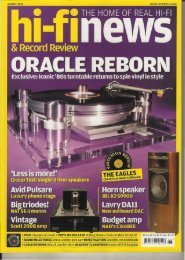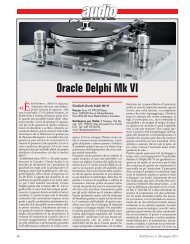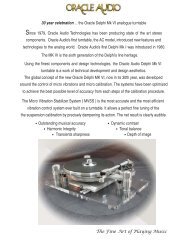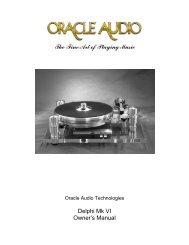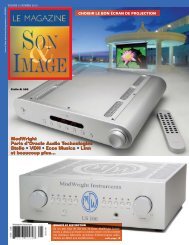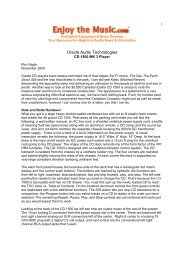DELPHI MARK IV - Oracle
DELPHI MARK IV - Oracle
DELPHI MARK IV - Oracle
Create successful ePaper yourself
Turn your PDF publications into a flip-book with our unique Google optimized e-Paper software.
ORACLE AUDIO<br />
<strong>DELPHI</strong> <strong>MARK</strong> V<br />
turntable<br />
OWNER’S MANUAL<br />
1<br />
by <strong>Oracle</strong> Audio Technologies inc.
TABLE OF CONTENTS<br />
Foreword .................................................................................................... 1<br />
How to ...<br />
... pack and unpack your Delphi ................................................................. 2<br />
... assemble the sub chassis ...................................................................... 3<br />
... adjust the plinth assembly ...................................................................... 3<br />
... install the tone arm and phono cartridge ................................................ 3 - 4<br />
... precisely align the phono cartridge ......................................................... 4<br />
... calibrate the suspension ......................................................................... 5 - 6 - 7<br />
... dress the phono lead .............................................................................. 8<br />
... install the drive belt ................................................................................. 8<br />
... remove the platter with the drive belt installed ........................................ 9<br />
... connect the power supply ....................................................................... 9<br />
... adjust the 33 / 45 speed ......................................................................... 9<br />
... attach the ground lead ............................................................................ 10<br />
... install and calibrate the hinges ............................................................... 10<br />
... operate the record clamp ........................................................................ 10<br />
... level your Delphi ...................................................................................... 10<br />
What to do ...<br />
... if .............................................................................................................. 11<br />
... for maintenance ...................................................................................... 12<br />
Foreword<br />
This is your Delphi MKV owner’s manual. The following pages will describe as<br />
succinctly as possible the assembly of your new Delphi. Although some operations<br />
are self explanatory, we strongly suggest you read this booklet to better understand the<br />
importance of the different key adjustments.<br />
Your Delphi is a precision instrument and its performance will be effected by the different<br />
adjustments. It is important to set up your Delphi with the utmost care so it can effectively<br />
convert record groove modulations into outstanding musical performance and enjoyment !<br />
Total accuracy of your source system can only be achieved through minute details of<br />
turntable suspension calibration, tone arm installation and cartridge alignment.<br />
2
H<br />
ow to ...<br />
... pack and unpack your Delphi<br />
- Remove the inner box by lifting it straight up and out. Open the flaps on both ends<br />
and slide out the styrofoam packaging.<br />
- Lift the styrofoam cover straight up so as to protect the corner reinforcement.<br />
Note 1:<br />
All the accessories are positionned strategically in the packaging to prevent<br />
them from coming loose and possibly damaging the turntable during shipping.<br />
IMPORTANT ! When shipping the turntable position each item in its allocated<br />
section.<br />
- The following items are located in the upper section of packaging.<br />
- Dust cover ( optional item ordered separately )<br />
- Calibrator disc<br />
- Main bearing lubricating oil<br />
- D.C. Power supply<br />
- Accessories bag<br />
- Drive belt<br />
- Linth free cloth<br />
- Suspension adjustment gauge<br />
- Tools pouch<br />
( screw driver, allen keys, 9/64"-3/32"-5/64" )<br />
Note 2:<br />
Lift the acrylic base straight up so as not to damage the platter’s spindle<br />
protruding through.<br />
- The following items are located in the bottom section of packaging.<br />
- Plinth assembly<br />
- Platter<br />
- Record clamp<br />
- Brillance cleaner<br />
- Hinges ( supplied with the dust cover option )<br />
- Strain relief clip<br />
- Main bearing assembly<br />
- One extra suspension spring<br />
- Three suspension caps<br />
Note 3:<br />
Your ORACLE’s packaging has been designed to protect it from the abusive<br />
handling normally encountered during shipping. Such packing materials are<br />
expensive and we recommend you save it for future shipping. It is mandatory<br />
to use the original packaging for any return to the factory.<br />
... assemble the sub chassis<br />
3
- Locate the bearing assembly in the lower section of the packaging. Remove the 3<br />
mounting screws.<br />
- Locate the tool kit in the lower section and select the appropriate allen key...<br />
9/64th<br />
- Lift the subchassis straight up and mount the bearing assembly from underneath<br />
(ground lug side). The bearing assembly can only be mounted in one position<br />
Note:<br />
Important, the main bearing mounting flange is marked with a red dot. When<br />
installed this red dot must be on the axis of the motor pulley and the platter<br />
spindle. Any other positionning will impair the operation of your Delphi.<br />
- Set the subchassis aside.<br />
... adjust the plinth assembly<br />
- Remove the styrofoam support blocks from around the suspension posts.<br />
- Remove the suspension modules ( ie. the suspension housing, the spring and all<br />
related parts ) Remember that each module has or could have a different color<br />
coded spring. The modules have to go back on the same stem they came from.<br />
- Remove the protective film from around the acrylic base.<br />
- Level the plinth by turning the adjustable feet below.<br />
Note:<br />
If you do not have a small carpenter's level to do this job, use the styrofoam<br />
blocks as they were originally installed around the three suspension posts.<br />
Seat the subchassis evenly on the 3 blocks and use the spirit level on the<br />
subchassis to level the plinth.The suspension modules are not required for<br />
this operation.<br />
... install the tone arm and phono cartridge<br />
Note 1:<br />
Note 2:<br />
Note 3:<br />
Note 4:<br />
The tonearm installation and calibration will be easier and safer with the<br />
sub-chassis resting on the foam shipping blocks as described earlier.<br />
The drive belt should not be used for this operation<br />
Do not pour the oil in the bearing well for this operation.<br />
Handle the platter installation carefully to prevent any damages to the<br />
bearing assembly.<br />
- Install the platter without the drive belt.<br />
- Place the tone arm mounting board loosely in the sub chassis mounting ring and<br />
determine the correct way to mount the arm to the arm board.<br />
- Mount the tone arm to the pre-cut tone arm board.<br />
- Install the tone arm following the manufacturer’s recommendations.<br />
- Properly secure the tone arm mounting hardware.<br />
... install the tone arm and phono cartridge ...<br />
4
Important ! If you are planning to cut your own mounting board, remember that the cutting<br />
of the arm board can sometimes be troublesome as well as being a potential hazard. The<br />
use of an adequate tooling is important to both accuracy and safety.<br />
- Use stainless steel or aluminum screws to mount the cartridge for maximum rigidity.<br />
- In preparation for the final alignment, tighten the screws so the cartridge can be<br />
moved in the headshell.<br />
... precisely align the phone cartridge<br />
Note 1:<br />
Note 2:<br />
The adequate use of the <strong>Oracle</strong> calibrator disc will insure an accurate<br />
cartridge alignment.<br />
Important ! Do not use tape to keep the platter from turning, doing so would<br />
damage the paint finish of the sub chassis or the platter.<br />
- Place the calibrator disc on the platter, over the mat.<br />
- Prevent the platter from turning for this operation.<br />
- Aim the alignment line ( Located over the " O " of <strong>Oracle</strong> ) with the pivot center of the<br />
tone arm.<br />
- Adjust the stylus pressure to approximately 1 gram.<br />
- Move the tone arm over the alignment grid and cue it down.<br />
Note 3:<br />
Important ! Any movement of the platter with the stylus cued down could<br />
result in irrevocable damage to the stylus or the cantilever.<br />
- Chek for the horizontality of the arm tube with the surface of the calibrator disc or<br />
use the tone arm manufacturer's supplied tool, adjust the height accordingly.<br />
- Bring the tone arm over the center of the grid again and lower it. The stylus tip<br />
must fit in the pin hole in the center of the grid. If not, position the cartridge so it<br />
does.<br />
- Precisely align the body of the cartridge with the lines of the grid. An other way<br />
would be to visualize the cantilever as an extention of the center line of the grid<br />
- Secure the cartridge screws and repeat the previous operation.<br />
- Check the azimuth ( lateral view of the cantilever ) by lowering the stylus over the<br />
black portion on the calibrator disc. The mirror reflection will help determine if the<br />
cartridge is off its vertical axis...<br />
- Check the stylus pressure and adjust it to the manufacturer's specifications.<br />
- Install the stylus guard to complete the assembly of your Delphi. Whenever<br />
possible, do not install the phono lead at this time.<br />
... calibrate the suspension<br />
Note 1:<br />
The spring tension of the suspension system can be adjusted two ways. First<br />
by using a different color coded spring. They are coded as follow from the<br />
weakest to the strongest, white ( rarely needed... not supplied ), yellow, red,<br />
green, blue and black ( rarely needed... not supplied ) The second is by<br />
5
changing the position of the spring in its holder. The color coding is visible<br />
from the inside at the wider end of the spring.<br />
Note 2:<br />
Note 3:<br />
Note 4:<br />
Step one<br />
The reference to clockwise or counter-clockwise is determined by viewing<br />
the spring from above, unless otherwise mentionned.<br />
By hand the spring can only be rotated counterclockwise in its holder but,<br />
using needle nose pliers, it can be held near the tip at the wider end. It is<br />
then possible to move it clockwise. If this cannot be done, rotate the<br />
spring counterclockwise until it comes out and reinsert it from under the<br />
holder leaving more of the spring out.<br />
Before installing the spring back into the suspension housing, hold it with<br />
one hand and pull on it at the wider end, this stretching will insure a<br />
positive seating in the threads of the holder.<br />
Pre-loading the spring.<br />
- Ajust the spring so three coils are showing below the holder.<br />
Step two<br />
Preparing a spring module.<br />
- Position the upper spring damper over the suspension stem.<br />
- Install the sorbothane damper over the spring holder and seat it well<br />
around the lip.<br />
- Insert the spring assembly into the suspension housing.<br />
- Install the suspension housing over the spring assembly.<br />
Note 5:<br />
The factory standard settings<br />
ALUMINIUM TOWERS:<br />
Yellow, front left module<br />
Red, rear left module<br />
Green, right module<br />
The blue spring is supplied as extra.<br />
GOLD TOWERS:<br />
Red, front left module<br />
Green, rear left module<br />
Blue, right module<br />
The yellow spring is supplied as extra.<br />
Note 6:<br />
Step three<br />
The standard spring combination will accommodate most tonearms.<br />
Calibrating the suspension.<br />
... calibrate the suspension...<br />
Note 7:<br />
Note 8:<br />
Before beginning this step the record clamp and an old record must be in<br />
place over the platter. This will give a more accurate operational mass of the<br />
sub chassis.<br />
Do not install the drive belt nor the phono lead so as to prevent any bias in<br />
the interpretation of the calibration.<br />
6
- Place the subchassis over the suspension modules.<br />
- Install the platter without the drive belt.<br />
- Locate the suspension gauge in the documentation envelope.<br />
- Punch the suspension gauge out of the card. Do not consider "A", nor 1 & 2, they<br />
were used on the earlier models.<br />
- Place the gauge on the acrylic base with the "B" side against the lock feet.<br />
- For the first round bring all three suspension housings at 3 mm (1/8" inch) above<br />
the "B" step on all three modules.<br />
- For the second round, reduce the increments to 1/8 of a turn or less until the<br />
suspension housing touches the step on the gauge very lightly.<br />
Note 9: With the spring adjusted as per step one, the bottom of<br />
the suspension housing should be well above the "B"<br />
step of the gauge.<br />
If it falls below... this is an indication that the spring used is too<br />
weak for this tonearm application.<br />
If a small adjustment is necessary to move the suspension<br />
housing above the ‘B’ line, remove the<br />
subchassis and move the<br />
weak<br />
spring counter clockwise in its holder ( looking at it from the<br />
wide side ). Start step three again.<br />
If the adjustment needed is important, identify the color code and use the next stiffer<br />
spring. With a new spring start the procedure again from step one.<br />
Note 10:<br />
Note 11:<br />
Note 12:<br />
Note 13:<br />
Aways start the calibration with the module near the tone arm then move to<br />
the rear left and finally to the front module.<br />
If the distance between the bottom of the suspension housing and the<br />
gauge is small, rotate the spring counter-clockwise by increments of ¼ of a<br />
turn, if the distance is large start by making full turns of the spring. Always<br />
apply a downward pressure on the record clamp to stretch the spring prior<br />
to taking a new reading.<br />
In the event that the suspension housing goes below the "B" step, start the<br />
precedure step one again.<br />
Once the proper adjustment is achieved, it is important as a final check to<br />
verify the relative position of the bottom of the spring with its holder. This can<br />
7
e done by simply lifting the suspension housing just enough so you can see<br />
the spring. If you can see the spring anywhere from almost flush to up to 3<br />
coils out of the spring holder, the spring is in a safe range. If the spring can<br />
not be seen showing below the holder a carefull inspection should be<br />
performed on this spring to make sure it is still at less than ½ turn<br />
inside the holder.<br />
... calibrate the suspension...<br />
Note 13:<br />
This is an indication that the spring is approaching its limits ( too soft<br />
for the application ). The use of a softer spring should be considered. Failing<br />
to do so could eventually cause the spring to slip out of its holder thus<br />
causing potential damage to your record and your phono cartridge!<br />
... dress the phono lead ( does not apply to the Delphi with a granit base edition )<br />
- The phono lead can now be connected to the base of your tone arm.<br />
- Secure the lead to the strain relief clip form above or below the plinth.<br />
Note 1:<br />
Note 2:<br />
Note 3:<br />
The lead must create a loop from the base of the tone arm to the strain<br />
relief clip. This is done to prevent any interference of the lead with the<br />
suspension system.<br />
In some applications, the phono lead might be too stiff and it is then<br />
recommended to split the molded wire from the plug to the strain relief.<br />
If the loop is too long, the lead could come in contact with the table below<br />
the turntable. If it is too short, it will keep the suspension system from<br />
moving freely. In both cases, this would be detrimental to the sound.<br />
... install the drive belt<br />
Note 1:<br />
To reduce contamination problems, wash your hands prior to handling the<br />
drive belt.<br />
- Remove the platter.<br />
- Pour some of the oil vial (3 cc) in the bearing and verify the level using the depth<br />
gage supplied with your turntable.<br />
- Locate the drive belt in the upper section of the packaging.<br />
- With the platter upside down, place the belt around the hub.<br />
- Bring the platter over the bearing and lower it straight down with one finger holding<br />
the belt stretched.<br />
- Guide the drive belt around the motor pulley when the spindle is 2/3 inside the<br />
main bearing.<br />
- Rotate the platter by hand a few turns to allow the belt to position itself around the<br />
hub and the motor pulley.<br />
Note 2:<br />
The special lubricating oil supplied with your Delphi is designed to protect<br />
and preserve the mating parts for many years.Unless contaminated with dirt<br />
or alcohol, this lubrication will last for many years<br />
8
Note 3:<br />
In the event that the drive belt becomes contaminated, clean it with<br />
denatured alcohol. Clean the motor pulley and the drive hub at the same<br />
time.<br />
... remove the platter with the drive belt installed<br />
Note:<br />
The following is not an operation related to the assembly of your Delphi but<br />
a procedure to prevent overstretching the drive belt.<br />
- Place one hand at the rear of the platter, over the motor, one hand at the front, lift<br />
the platter about 2.5 cm (one inch) and with one finger pull the belt off the motor<br />
pulley, then lift the platter straight up. Lifting the platter without looking after the<br />
drive belt could possibly damage it.<br />
... connect the power supply<br />
- Plug the power supply output to the turntable input receptacle located to the rear of<br />
the turntable.<br />
- Plug the input cord to an AC outlet.<br />
Note:<br />
Keep the power supply away from signal carrying leads.<br />
... adjust the 33 and 45 speed<br />
Note 1:<br />
Note 2:<br />
Note 3:<br />
Note 4:<br />
Note 5:<br />
The 33 speed must always be calibrated first.<br />
The individual speed potentiometers are accessible from the rear of the drive<br />
module. When viewing the module from the rear, a clockwise rotation of the<br />
potentiometer will result in an increase of the selected speed.<br />
The inner circles of strobe marks on the calibrator disc are to be used with a<br />
supply of 50 Hz. The circle near the center is for 33 RPM, the other one is for<br />
45 RPM. The outer circles are to be used with a supply of 60 Hz. The<br />
outermost circle is for 45 RPM, the one next to it is for 33 RPM.<br />
The use of incandescent or preferably, fluorescent lighting is required to<br />
accuratly read the calibrator disc.<br />
When the right speed is reached the appropriate set of strobe marks will be<br />
standing still ( with no movement forewards or backwards )<br />
- Place the calibrator disc over the spindle, on the platter.<br />
- Select the 33 speed and check for accuracy.<br />
- Select the 45 speed and check for accuracy.<br />
- If both speeds need to be corrected, select the 33 speed again and, using the small<br />
screw driver supplied with the tool kit, rotate the 33 speed potentiometer ( to the left,<br />
when viewing the module from the rear ) until the strobe marks on the calibrator disc<br />
come to a standstill position.<br />
- Check the 45 speed again, if a small correction is still required, rotate the 45 speed<br />
potentiometer.<br />
9
... attach the ground lead<br />
- Loosen the thumb nut from under the sub-chassis near the tonearm and insert one<br />
end of the lead.<br />
- Attach the other end of the lead to the ground post of your pre-amplifier.<br />
... install and calibrate the hinges<br />
( Supplied when purchasing the optional dust cover )<br />
- Locate the hinges in the lower section of the packaging and the appropriate allen<br />
key ( 3/32" ) from the tool kit.<br />
- Mount the hinges to the plinth and do not tighten the screws completely. Make sure<br />
the dust cover slots line up correctly with each other before the final tightening.<br />
- Install the dust cover by sliding it in the hinges slot.<br />
Note: If the dustcover can not be lifted totally<br />
open in its playing area, it is possible to change the<br />
spring tension of the hinges. The tension have been<br />
pre-adjusted on both hinges at the factory to its best<br />
performance.<br />
... operate the record clamp<br />
- Tighten the clamp so the record is pushed flat<br />
against the mat.<br />
Note : Damages may occur to your albums when<br />
overtightening the record clamp.<br />
... level your Delphi<br />
Your turntable is now ready to be moved to its final location.<br />
- Level the acrylic base by turning the leveling feet. Use the subchassis spirit level to<br />
complete this final adjustment since the relative level has already been established<br />
between the subchassis and the acrylic base.<br />
What to do ...<br />
... if the turntable does not start and the speed indicating light does not go on<br />
Check: - AC connection to the wall outlet.<br />
- power supply output plug to the input receptacle of the turntable.<br />
- power supply output, if not output, replace the fuse inside.<br />
Use 0.25 amp / 250vac for 100 and 120 volts line input.<br />
Use 0.1 amp / 250vac for 200 and 220 volts line input.<br />
... if the turntable does not start and the speed indication light goes on<br />
10
Check:<br />
- drive belt<br />
- motor connection plug for a broken wire<br />
- drive module for a broken wire<br />
- defective drive module<br />
... if the platter is not parallel with the plinth<br />
Check:<br />
Note:<br />
Read:<br />
- suspension calibration using the suspension gauge<br />
If a relatively important change occured in one particular suspension module,<br />
it could be the sign of an improperly seated spring of sorbothane ring. Check<br />
the installation carrefully prior to calibrating again.<br />
- section How to ... calibrate the suspension<br />
... if an even up or down motion cannot be obtained when gently pressing on the<br />
record clamp<br />
Check:<br />
Read:<br />
- leveling of the base<br />
- for phono lead interference with the movement of the suspension. If<br />
uncertain, unplug the lead.<br />
- previous topic: ... if the platter is not parallel with the plinth.<br />
... if 33 and 45 speed becomes erratic`<br />
Check:<br />
- drive belt to make sure it rides in the center of the motor pulley.<br />
- motor pulley height (should be 71 mm (2.800 in.) from the top of the<br />
pulley to the acrylic base).<br />
- lubrication in main bearing.<br />
- drive belt for oil contamination<br />
- drive belt for excessive wear<br />
- for damaged of defective main bearing<br />
- motor connection plug for a broken wire<br />
- drive module for a broken wire<br />
- defective motor<br />
- defective drive module.<br />
... for maintenance<br />
- The blue cloth supplied can be used to clean all the metal, acrylic parts and the mat.<br />
Always use the cloth dampened with water to dust the acrylic parts. Do not use this<br />
cloth to pick up oil spills, keep it for the delicate work.<br />
- Unless contaminated, there will be no need to dismantle the main bearing. If<br />
required it is simple to disassemble it from the subchassis. Keep the bearing ass’y<br />
vertical since it contains oil. If the oil is contaminated it must be disposed of<br />
ecologically. Remove the 3 socket head capscrews holding the bottom cover.<br />
Clean the thrust pad and the inside of the bearing well with denatured alcohol using<br />
a cotton swab. Allow a few minutes for the parts to dry. Reassemble, making sure<br />
11
to firmly secure the screws. Do not forget to add the content of one oil vial (about 3<br />
cc) before installing the platter.<br />
- As a precaution to preserve the furniture your Delphi sits on, it is advisable to use a<br />
folded paper towel under the main bearing for a few weeks in the case of a bearing<br />
spillage.<br />
- The drive belt should be replaced yearly for optimal performance.<br />
We are confident your new <strong>Oracle</strong> product will give you many years of satisfaction.<br />
You are now ready for the real and only purpose of all this... to sit down and relax, to<br />
just listen and enjoy beautiful music.<br />
The people at <strong>Oracle</strong> Audio Technologies inc.<br />
6136 boulevard Bertrand Fabi, suite 101<br />
Rock Forest. Quebec. Canada<br />
J1N 2P3<br />
phone: 1-819-864-0480 fax: 1-819-864-9641<br />
e-mail : info@oracle.audio.com<br />
www.oracle-audio.com<br />
12


